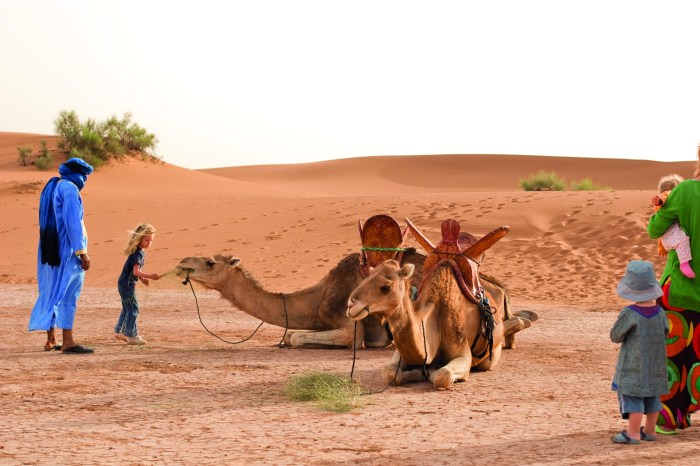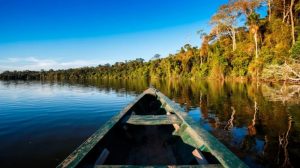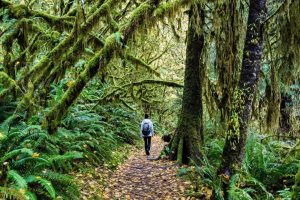
Embark on a journey through the sandy dunes and arid landscapes as we dive into the world of sustainable travel in desert regions. Discover eco-friendly practices, innovative conservation methods, and the beauty of traveling responsibly in these unique terrains. Get ready for an adventure like no other!
Mountain Travel

When it comes to traveling sustainably in mountain regions, there are several practices that can help minimize the impact on the environment while still enjoying the beauty of these natural landscapes.
Examples of Sustainable Practices for Mountain Travel
- Choose eco-friendly accommodations that follow green practices, such as using renewable energy sources or minimizing waste.
- Support local communities by purchasing goods and services from small businesses rather than large corporations.
- Opt for hiking or biking instead of using motorized vehicles to explore the mountains, reducing carbon emissions.
- Follow Leave No Trace principles by packing out all trash and leaving nature undisturbed.
Impact of Tourism on Mountain Ecosystems
While tourism can bring economic benefits to mountain communities, it can also have negative consequences on the delicate ecosystems. Increased foot traffic, pollution, and habitat destruction can all harm the plants and animals that call the mountains home.
Tips on Reducing Carbon Footprint while Traveling in Mountain Regions
- Use public transportation or carpooling to reduce emissions from long-distance travel.
- Bring a reusable water bottle and snacks to minimize single-use plastic waste.
- Stay on designated trails to avoid trampling sensitive vegetation.
- Offset your carbon footprint by supporting reforestation projects or investing in renewable energy initiatives.
Desert Travel
Desert travel presents unique challenges due to the scarcity of water and harsh environmental conditions. It is essential to prioritize water conservation practices to ensure sustainability and minimize the impact on fragile desert ecosystems.
Importance of Water Conservation
Water is a precious resource in desert regions, and its conservation is crucial for both the environment and the well-being of travelers. By reducing water usage through efficient practices such as shorter showers, reusing towels, and minimizing laundry, travelers can help preserve limited water supplies in the desert.
Minimizing Waste in Desert Regions
- Opt for reusable water bottles and containers to reduce single-use plastic waste.
- Properly dispose of trash and pack out all garbage to keep the desert environment clean.
- Choose eco-friendly products and packaging to minimize waste generation during desert travel.
Traditional vs. Modern Sustainable Approaches
| Traditional Methods | Modern Sustainable Approaches |
|---|---|
| Relying on animal transportation | Using low-impact, fuel-efficient vehicles for travel |
| Collecting water from natural sources | Implementing advanced water filtration systems for water conservation |
| Leaving behind waste in the desert | Packing out all garbage and following Leave No Trace principles |
Arctic & Polar Travel

When it comes to sustainable travel in Arctic and polar regions, there are unique challenges that need to be taken into consideration. The extreme weather conditions, delicate ecosystems, and limited infrastructure pose significant obstacles for travelers looking to explore these remote areas. However, with careful planning and a commitment to conservation, it is possible to enjoy the beauty of the Arctic while minimizing negative impacts on the environment.
Wildlife Conservation Efforts in Arctic Travel Destinations
- Many Arctic travel destinations are home to a diverse range of wildlife, including polar bears, walruses, and various bird species.
- Conservation efforts in these regions focus on protecting these vulnerable species and their habitats from the impacts of climate change, pollution, and human disturbance.
- Initiatives such as wildlife monitoring, habitat restoration, and educational programs help raise awareness about the importance of preserving Arctic wildlife.
Role of Indigenous Communities in Promoting Sustainable Tourism in the Arctic
- Indigenous communities in the Arctic have a deep connection to the land and wildlife, making them key stakeholders in sustainable tourism efforts.
- These communities often offer unique cultural experiences, such as traditional storytelling, music, and art, that provide visitors with a deeper understanding of the region’s history and heritage.
- By engaging with and supporting indigenous-led tourism initiatives, travelers can contribute to the economic development of these communities while respecting their cultural traditions and values.
Jungle & Rainforest Travel
Jungle and rainforest travel offer unique opportunities to immerse oneself in some of the most biodiverse ecosystems on the planet. It is crucial to preserve the biodiversity of these regions to protect countless plant and animal species that call the jungle and rainforest home.
Preserving Biodiversity in Jungle and Rainforest Travel
Preserving biodiversity in jungle and rainforest travel is essential to ensure the survival of numerous species that rely on these ecosystems for their habitat. By supporting sustainable tourism practices, visitors can help protect the delicate balance of life in these regions.
- Engage in eco-friendly activities such as wildlife watching tours that are led by knowledgeable guides who prioritize the well-being of the animals.
- Stay at eco-lodges that are built with minimal impact on the surrounding environment and support local conservation efforts.
- Participate in reforestation projects to help restore areas that have been affected by deforestation.
Sustainable Accommodations in Rainforest Regions
There are several sustainable accommodations in rainforest regions that prioritize environmental conservation and support local communities.
- Treehouse lodges that are built using sustainable materials and offer a unique experience of living among the treetops.
- Eco-resorts that utilize renewable energy sources such as solar power and practice water conservation measures.
- Community-run guesthouses that provide visitors with an authentic cultural experience while supporting local livelihoods.
Impact of Deforestation on Sustainable Travel in Jungle Areas
Deforestation has a significant impact on sustainable travel in jungle areas, threatening the biodiversity and ecological balance of these regions.
- Loss of habitat for wildlife leads to a decline in species diversity and disrupts the delicate ecosystems of the jungle and rainforest.
- Deforestation contributes to climate change by releasing carbon dioxide into the atmosphere, affecting the global climate and weather patterns.
- Reduced forest cover diminishes the natural beauty and appeal of jungle and rainforest destinations, impacting the tourism industry and local communities that depend on it.
Coastal & Beach Travel
When embarking on coastal and beach travel, responsible waste management is crucial to minimize the impact on the environment. It is important to remember that these areas are delicate ecosystems that can easily be harmed by improper waste disposal. By following a few simple tips, travelers can contribute to preserving the beauty of coastal destinations for future generations.
Tips for Responsible Waste Management
- Avoid single-use plastics such as straws, water bottles, and plastic bags. Opt for reusable alternatives to reduce plastic waste.
- Properly dispose of trash in designated bins and recycling facilities. If bins are not available, carry your trash with you until you find a suitable disposal point.
- Participate in beach clean-up activities organized by local conservation groups or hotels. This hands-on approach helps remove litter from the beach and prevent harm to marine life.
Protecting Marine Life in Coastal Destinations
- Avoid touching or disturbing marine animals such as sea turtles, dolphins, and seals. Keep a safe distance to prevent stress or harm to these creatures.
- Choose reef-safe sunscreen to protect coral reefs from harmful chemicals. Chemicals found in some sunscreens can bleach and damage coral, affecting the entire marine ecosystem.
- Support sustainable seafood practices by choosing restaurants that serve locally sourced, responsibly caught seafood. Overfishing can deplete marine populations and disrupt the balance of the ecosystem.
Eco-Friendly Activities for Sustainable Tourism
- Try paddleboarding or kayaking to explore coastal areas without disturbing marine life. These activities allow you to appreciate the beauty of the ocean while minimizing your carbon footprint.
- Join guided tours led by local experts who prioritize environmental conservation. Learn about the wildlife and ecosystems of the area while supporting sustainable tourism practices.
- Engage in snorkeling or scuba diving responsibly by following guidelines to protect coral reefs and marine habitats. Respect underwater wildlife and refrain from touching or collecting marine organisms.
Last Word
As we conclude our exploration of sustainable travel in desert regions, remember that every step we take leaves an impact on the environment. By embracing eco-friendly practices and respecting the fragile ecosystems of deserts, we pave the way for a more sustainable future in these arid lands. Let’s continue to travel responsibly and preserve the beauty of desert regions for generations to come.
Question & Answer Hub
How can I conserve water in desert travel?
One way to conserve water is by taking shorter showers and reusing towels to reduce laundry.
What are some eco-friendly activities in desert regions?
You can participate in desert clean-up initiatives or opt for guided tours that focus on wildlife conservation.
Is it possible to travel sustainably in the desert without leaving a carbon footprint?
Absolutely! You can choose eco-friendly accommodations, minimize waste, and support local conservation efforts to reduce your carbon footprint.





